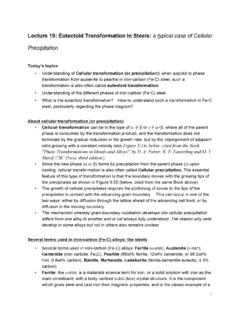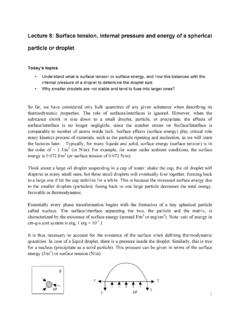Transcription of Microscopy: Principles and Advances - University of Ljubljana
1 microscopy : microscopy : microscopy : microscopy : microscopy : microscopy : microscopy : microscopy : Principles and AdvancesPrinciples and AdvancesPrinciples and AdvancesPrinciples and AdvancesPrinciples and AdvancesPrinciples and AdvancesPrinciples and AdvancesPrinciples and AdvancesChandrashekhar V. KulkarniChandrashekhar V. KulkarniChandrashekhar V. KulkarniChandrashekhar V. KulkarniUniversity of Central Lancashire, Preston, United kingdomUniversity of LjubljanaMay, 2014 May, 2014 May, 2014 May, 201422005-2008: PhD-Chemical BiologyProf. Richard Templer, Dr. Oscar Ces, Prof. John Seddon(Chemistry) Prof. So Iwata (Biochemistry), United Kingdom2008-2010: Postdoctoral Research AssistantProf.
2 Otto Glatter, Scattering Methods Research GroupChemistry- University of Graz, Austria2011-2011: Postdoctoral Research AssociateProf. Matthias Weiss, Experimental Physics IPhysics- University of Bayreuth, Germany2012-2013: Postdoctoral Research AssociateDr. Ulrich F. Keyser, Nanopores Research GroupPhysics- University of Cambridge, United : Assistant Professor and Group LeaderLipid Nanostructures Group, Centre For Materials ScienceUniversity of Central Lancashire, United KingdomAcademic Background3 Microscopic Eye!Can you see it with eyes? Can you make it seeing with eyes? waterClean waterClean?4 Why to Use Microscopes?1. See things (objects,orgamisms) that are not visible with naked eye2.
3 Study morphological properties at micro- andnano-scale lengths3. Collect images at high resolution4. Observe live phenomena (live cells, chemical reaction) under microscope5 LimitsEye: mmMicroscope: x1000 Electron Microscope: x1000x1000 Human hairBlood CellsDNA, organelles6 Types of based on what interacts with sampleLightElectronsProbescanning near-field optical microscopy scanning tunneling microscopySample7 Light MicroscopesSampleLens: to focus light on sampleLight sourceTransmitted lightLens: to focus light into an eye, objective, cameraStacking of lenses to increase magnificationeye, objective, Types of Light Microscopes Bright Field: simplest, used for basic observations Dark Field.
4 Better contrast but reduces light illumination Polarized Light: anisotropic samples, based on birefringence Phase contrast: uses difference in refractive indicesShrikhand with Nuts, Saffron9 Liquid Crystalline Fat StructuresFat Re-crystallization at Room Temp. (cross polarized light) 2 minutes6 hoursAnnealing at 40 C50 mMelting of Fat StructuresMelting and Re-crystallization of Lipids/FatsKulkarni * (2012) Nanoscale, 4, 5779-579110 Fluorescence MicroscopyFluorescent MicroscopyExcite with high energy light, they emit light of a different, lower frequency (long wavelength)ExcitedStateGiant Unilamellar VesiclesW/O nanostructured emulsionKulkarni * (2012) Nanoscale, 4, 5779-579111 Other than Visible Light MicroscopyVisible Light MicroscopeIR Microscope/Raman Microscope UV MicroscopeX-ray MicroscopyLimitations of wide field microscopes.
5 Low resolution, Out of focus light, Diffracted lightStudy planeSpecial type of mirrorOnly in focus light is image reconstruction13 Electron Structure by TEMS urface Structure by SEM14 Cryo-EM image of GroEL at 50,000X GroEL molecular machine that functions in folding of many proteins in surface of houseflySEMTEME xamples: Electron MicroscopyCryo-to keep structure intact(biological and soft samples)15 Probe ~lzang/ : Atomic Force Microscopy16 Contact modeNon-contact modeCantileverModes of Cantilever17 Images by Atomic Force MicroscopySurface topographyNanoscaledimensionsMicro- to nano-scale informatonMicro- to nano-scale information18 Advances in MicroscopyTechniques with Confocal Laser Scanning microscopy : Fluorescence Correlation Spectroscopy (FCS) Live Cell Imaging Fluorescence Lifetime Imaging microscopy (FLIM) Forster Resonance energy Transfer (FRET) Fluorescence Recovery After Photo-bleaching (FRAP)Super-resolution MicroscopyTotal Internal Reflection microscopy (reaching nano by an eye)Mutiphoton Microscopy19 Thank You!
6 Dr. Dr. Dr. Dr. Chandrashekhar Chandrashekhar Chandrashekhar Chandrashekhar V. KulkarniV. KulkarniV. KulkarniV. : +44-1772-89-4339 Lipid Nanostructures Group Centre for Materials ScienceSchool of Forensic and Investigative SciencesUniversity of Central LancashirePreston PR1 2 HEUnited Kingdom. Webpage:Contact DetailsEmail.

